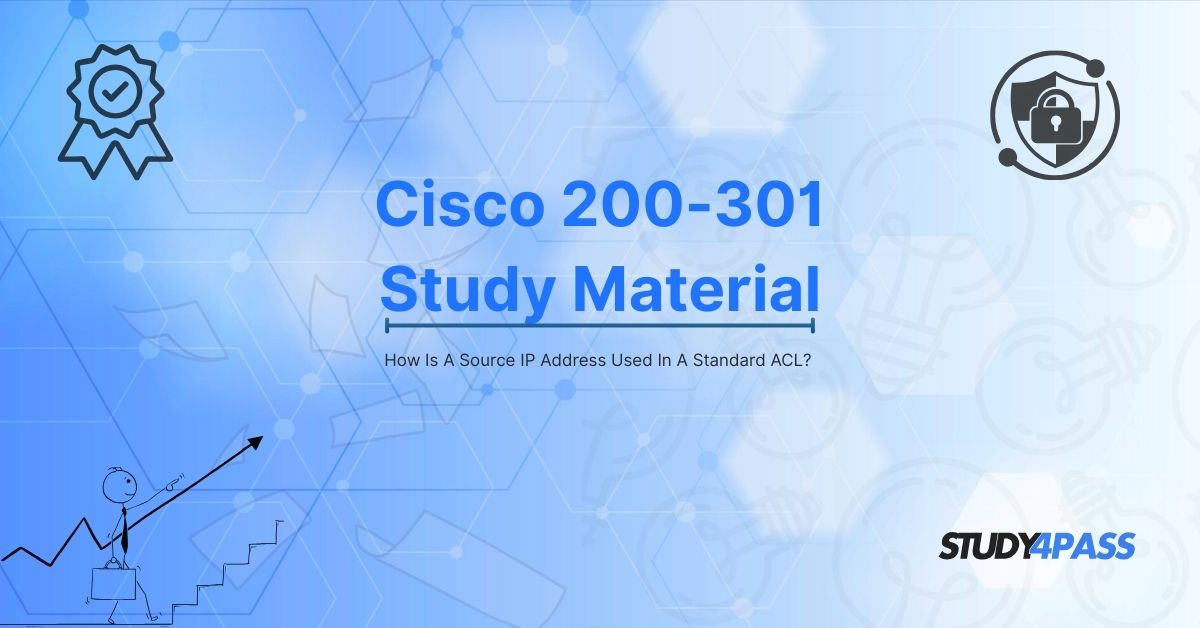Introduction to Access Control Lists
Access Control Lists (ACLs) are a fundamental component of network security, used to filter traffic based on predefined rules. In Cisco networking, ACLs play a crucial role in permitting or denying traffic flow. A Standard ACL is one of the simplest types of ACLs, primarily filtering traffic based on the source IP address.
This article explores how a source IP address is used in a Standard ACL, its configuration, and its significance in network security. Additionally, we will discuss how Study4Pass provides high-quality Cisco 200-301 study material and CCNA CyberOps Associate (Version 1.0) resources to help aspiring network professionals master these concepts.
Understanding Standard ACLs
A Standard Access Control List (ACL) is a sequential list of permit or deny statements that control traffic based on:
- Source IP address
- Wildcard mask (optional, for grouping IP addresses)
Unlike Extended ACLs, which can filter based on source/destination IP, port numbers, and protocols, Standard ACLs only consider the source IP address.
Key Characteristics of Standard ACLs
- Filters Traffic Based on Source IP Only – Does not consider destination IP, port, or protocol.
- Uses Numbered (1-99, 1300-1999) or Named ACLs – Older Cisco devices use numbered ranges.
- Processed Top-Down – The first matching rule is applied; if no match, an implicit deny any blocks all remaining traffic.
- Best Placed Near the Destination – Since it filters based on source, placing it too close to the source may unintentionally block legitimate traffic.
How Source IP Address is Used in Standard ACLs?
The source IP address is the primary criterion in a Standard ACL. Below is a breakdown of its role:
1. Identifying Traffic Origin
- A Standard ACL checks the source IP field in the packet header.
- If the source IP matches an ACL rule, the corresponding permit/deny action is applied.
2. Wildcard Mask for IP Range Filtering
- A wildcard mask (inverse of subnet mask) specifies a range of IP addresses.
- Example:
- ACL Rule: access-list 10 permit 192.168.1.0 0.0.0.255
- Interpretation: Permits all traffic from 192.168.1.0/24 network.
3. Implicit Deny Any
-
If no rule matches, Cisco applies an automatic deny any at the end.
- Example:
access-list 20 permit 10.1.1.1
access-list 20 deny 10.1.1.2
- Only 10.1.1.1 is allowed; all other IPs are blocked.
Configuring a Standard ACL in Cisco Devices
Here’s a step-by-step configuration example:
Step 1: Create the ACL
Router(config)# access-list 10 permit 192.168.1.1
Router(config)# access-list 10 deny 192.168.1.2
Router(config)# access-list 10 permit 192.168.1.0 0.0.0.255
Step 2: Apply the ACL to an Interface
Router(config)# interface GigabitEthernet0/0
Router(config-if)# ip access-group 10 in
Step 3: Verify the ACL
Router# show access-lists
Use Cases of Standard ACLs
- Basic Traffic Filtering – Allow/block specific hosts.
- Routing Updates Control – Restrict OSPF or EIGRP neighbors.
- Security Policies – Prevent unauthorized access from certain subnets.
Why Study4Pass is the Best Platform for CCNA & CyberOps Preparation?
When preparing for Cisco 200-301 (CCNA) or CyberOps Associate (Version 1.0), having the right study material is crucial. Study4Pass stands out because:
- Comprehensive Cisco 200-301 Study Material – Covers ACLs, routing, switching, and security.
- CCNA CyberOps Associate (Version 1.0) Resources – Detailed labs and real-world scenarios.
- Structured Learning Path – Step-by-step guides for beginners to experts.
- Exam-Focused Practice Tests – Simulates real Cisco exams for better preparation.
By choosing Study4Pass, you gain access to high-quality, exam-focused content that ensures success in Cisco certifications.
Final Verdicts
A Standard ACL filters traffic based solely on the source IP address, making it a simple yet powerful tool for network security. Understanding its configuration and application is essential for CCNA 200-301 and CyberOps Associate exams.
For the best Cisco certification preparation, Study4Pass provides expertly crafted study materials, ensuring you master ACLs and other networking concepts efficiently.
Start your journey with Study4Pass today and achieve your Cisco certification goals!
Special Discount: Offer Valid For Limited Time “Cisco 200-301 Exam Study Guide”
Actual exam question from Cisco's 200-301 Exam Questions.
Sample Questions for Cisco 200-301 CCNA certification
1. In a Standard ACL, what does the source IP address identify?
A) The destination of the traffic
B) The origin of the traffic
C) The protocol being used
D) The port number of the traffic
2. What is the primary function of a Standard ACL when using a source IP address?
A) Filter traffic based on destination IP
B) Filter traffic based on source IP only
C) Filter traffic based on both source and destination ports
D) Encrypt traffic from a specific source
3. Where should a Standard ACL (using source IP) typically be placed for optimal performance?
A) As close to the destination as possible
B) As close to the source as possible
C) On a core router only
D) On a switch instead of a router
4. Which of the following commands correctly applies a Standard ACL to block traffic from source IP 192.168.1.10?
A) access-list 10 deny 192.168.1.10 0.0.0.0
B) access-list 10 permit 192.168.1.10 255.255.255.255
C) access-list 100 deny tcp any any
D) access-list 10 deny host 192.168.1.10
5. What is a limitation of using a Standard ACL that filters only by source IP?
A) It cannot distinguish between different types of traffic (e.g., HTTP vs. FTP).
B) It encrypts the traffic from the source.
C) It filters based on destination ports.
D) It requires both source and destination IPs to function.


